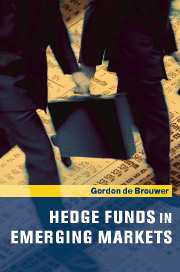Book contents
- Frontmatter
- Contents
- List of figures
- List of tables
- Preface
- 1 The issues
- 2 What is a hedge fund?
- 3 Hedge funds in east Asia
- 4 Hong Kong
- 5 Indonesia, Malaysia and Singapore
- 6 Australia and New zealand
- 7 Models of market dynamics
- 8 Inferring hedge fund positions from returns data
- 9 Looking forward
- References
- Index
7 - Models of market dynamics
Published online by Cambridge University Press: 22 September 2009
- Frontmatter
- Contents
- List of figures
- List of tables
- Preface
- 1 The issues
- 2 What is a hedge fund?
- 3 Hedge funds in east Asia
- 4 Hong Kong
- 5 Indonesia, Malaysia and Singapore
- 6 Australia and New zealand
- 7 Models of market dynamics
- 8 Inferring hedge fund positions from returns data
- 9 Looking forward
- References
- Index
Summary
Economists have long been puzzled by substantial overshooting of asset prices from their perceived fundamental value. The sharp rise and subsequent crash of the UK stock market in October 1987, for example, provoked a fiurry of research examining the regularity of such events and trying to explain how they could occur. In elementary rational expectations models, movements in prices occur because market participants receive new information. But many movements in asset prices, even large and sustained ones, appear not to be explained by new information.
The literature on the microstructure of financial markets seeks to address some of these issues, and shows that movements in prices can occur for many reasons, including because of the trading mechanism itself, the types of trades made, and the strategies of different types of traders (O'Hara 1995). The aim of this chapter is not to summarise the already large and expanding literature on market microstructure but to selectively identify and set out some of the main models that are relevant to the issue of this book: how, as shown by the experiences of 1997 and 1998 in east Asian financial markets, large informed players can affect financial-market dynamics.
The exposition in this chapter comprises three parts. The first looks at the literature on herding in financial markets, focusing on semi-rational herding models with noise traders and rational herding models due to information cascades and principal-agent concerns.
- Type
- Chapter
- Information
- Hedge Funds in Emerging Markets , pp. 144 - 170Publisher: Cambridge University PressPrint publication year: 2001



